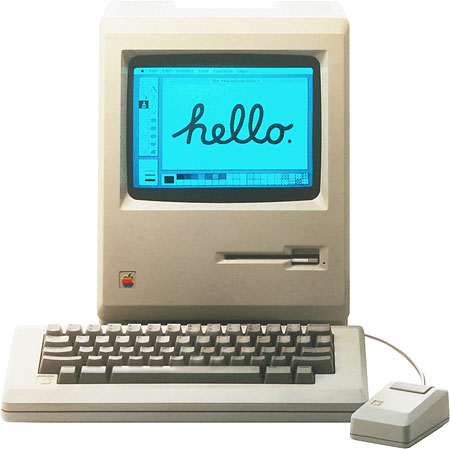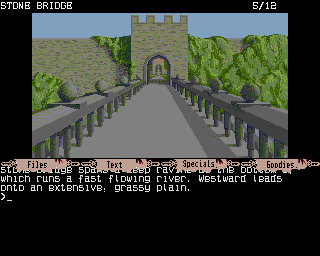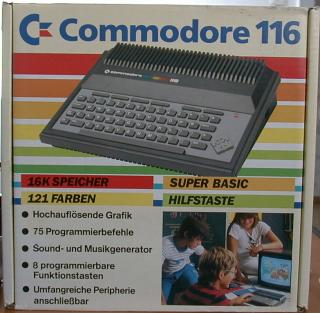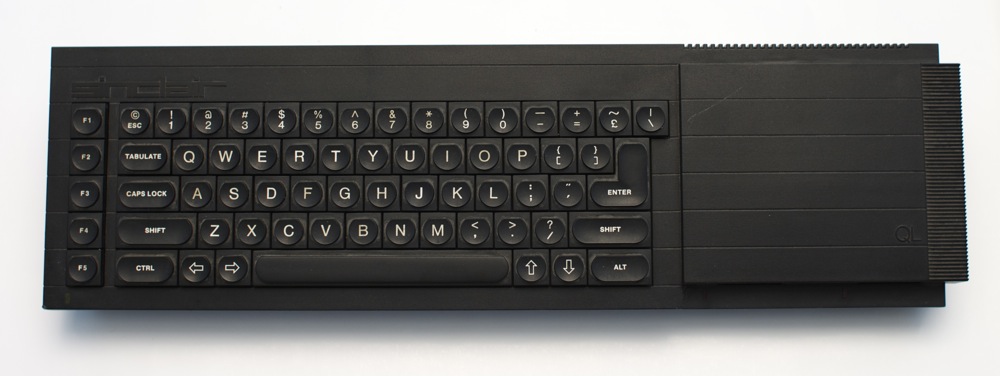HAPPY 30th ANNIVERSARY TO THE APPLE MAC, SINCLAIR QL, & AMSTRAD CPC464!
 The original Apple MacIntosh from 1984
The original Apple MacIntosh from 1984
This year, 2014, is the 30th anniversary of the Apple MacIntosh, the Sinclair QL, and the Amstrad CPC464!
All of these computers were very user friendly, because they were each supplied with versions of the programming language BASIC, which supported their hardware, unlike the Commodore 64.
The Apple MacIntosh was a computer based around the 32 bit 68000 CPU, although it had a 16 bit data bus. It was the first popular, mass market computer to use a system of windows, icons, mouse, and pull down menus, which was called a WIMP system at the time. It could also speak, although so could much less advanced 8 bit computers. Steve Jobs introduced it to the public in the demo on http://www.youtube.com/watch?v=G0FtgZNOD44 . In spite of all its innovations, it was based on the Xerox Star and was also a cut down version of the short lived Apple Lisa, which was even more expensive than the Macintosh. It was supplied with software which included Mac Paint and Mac Write, so users could easily draw pictures and do word processing, which many Commodore 64 owners never did at all, because Commodore didn’t supply a BASIC language or any software with the C64 which enabled them to do these things, then they were brainwashed into just playing games instead. It also came with Microsoft BASIC for MacIntosh, which supported its WIMP system, although Apple’s own MacIntosh BASIC had to be shelved to get Microsoft to agree to renew their licence for Applesoft BASIC on the Apple ][. This version of BASIC was later ported to the Amiga computer, which wasn’t developed by Commodore, they just bought the company Amiga. First of all it was called Microsoft BASIC, then soon changed its name to AmigaBASIC, but hardly had any changes made to it compared to the original MacIntosh version. The original MacIntosh only had a mono display, but AmigaBASIC, so presumably Microsoft BASIC for MacIntosh also, had commands for colour built in for future expansion, but I can’t confirm this. Unfortunately, BASIC on the MacIntosh wasn’t used anything like as much as on the Apple ][. A number of other languages, including C and LOGO, were soon made available for the MacIntosh. It was often featured in books and magazine articles as being one of at least a few different computers, including the Amiga, and the Atari ST, with “similar” WIMP facilities, which you could “easily” write the same programs for using C.
Later on, this version of Microsoft BASIC was discontinued and not much documentation about it is available. The commands (on the Amiga version at least) include AREA, AREAFILL, CIRCLE, COLLISION, LOCATE y,x, MOUSE (number), MOUSE ON/OFF/STOP, MENU, WHILE…WEND, WINDOW, as well as interrupt commands such as ON MENU, ON MOUSE, and ON TIMER. Unfortunately, after Microsoft BASIC for the MacIntosh was discontinued in 1995, or even earlier, the Apple MacIntosh started being sold without a programming language at all! The Amiga also started being sold without AmigaBASIC or any programming language after about 7 years, although other versions of BASIC (i.e. AMOS) were available and could be compiled or supplied as a runtime version.
The Sinclair QL took a quite different approach from the Apple MacIntosh. It was publicised in this TV commercial http://www.youtube.com/watch?v=AO5BUIKykMM . Although they both came with 128K RAM and could both run 68000 Machine Code, the Sinclair QL used the cut down 68008 CPU with an 8 bit data bus, had no WIMP system and was designed to be low priced instead of to have a high specification, although considering the competitors’ prices, most businesses didn’t seem to really mind how much they paid for their computers, unlike home users. Here’s a video giving an extensive tour of the QL, including the features which put off business users, although it was totally superior to the Commodore 64 in almost every aspect apart from the keyboard and its ability to play music http://www.youtube.com/watch?v=kCKercQxHrk . The QL powered up into a display setting menu, then dropped the user into QL SuperBASIC, which has procedures and long variable names, similar to COMAL and BBC BASIC. It also had a system called QDOS for accessing files, but this was nothing to do with the CP/M copyist QDOS bought by Microsoft which they based PC DOS and MS-DOS on. It had two Sinclair microdrives, meaning a fast tape cartridge system, built in, but could have one or more of the new 3.5 inch disk drives added on, the keyboard was poor quality and flat, which most businesses didn’t like the feel of at all. Despite its imaginative and creative features, it was a failure for Sinclair, but it attracted a loyal and fanatical following.
 The adventure game “The Pawn” was first released on the Sinclair QL
The adventure game “The Pawn” was first released on the Sinclair QL
The text and graphics adventure “The Pawn” by Magnetic Scrolls, with an advanced parser or interpreter for typed in commands, was originally released for the QL, before any other computers, such as the MacIntosh, Amiga, and Atari ST, and even some 8 bit computers, although it’s hard to believe that the parser could have been as sophisticated on 8 bit computers. The Sinclair QL board was also adapted into different versions called the ICL One Per Desk, and the BT Merlin. Its case and keyboard was later adapted for the Spectrum Plus. Linux creator Linus Torvalds, who had a unlucky start on the Commodore VIC-20, which even so was far less complicated and easier to program than the Commodore 64, moved on to become a Sinclair QL user. After Sinclair Research was bought out by Amstrad in 1986, various groups and companies, such as CST, tried to revamp the QL into a more powerful and more professional computer called the CST Thor. QL enthusiasts are still continuing today, including computers which are much more advanced versions of the QL available on http://www.q40.de/ .
 The Amstrad CPC464, complete with integrated colour monitor containing the PSU
The Amstrad CPC464, complete with integrated colour monitor containing the PSU
The Amstrad CPC464 was quite different to the MacIntosh and QL, being similar to the Sinclair Spectrum in many ways, but more powerful. It was aimed partly at people who wanted to upgrade from the Spectrum, by using the familiar Z80A CPU, but with a proper keyboard, a built in cassette drive, as well as Locomotive BASIC, which contained over 150 commands, including some which were the same as in Sinclair BASIC, such as BORDER, INK, and PAPER. Locomotive BASIC went beyond Sinclair BASIC by including structured programming such as the WHILE…WEND loop, long variable names, interrupts from BASIC, and the command MODE [number] which selected one of three display modes similar to the BBC Micro, because it used the same 6845 video chip, although it was set up to have a border around the main screen, unlike the BBC. It could display 16, 4, or 2 colours, selected from a palette of 27. It was the first in a range of CPC models, but the only one released in 1984. It was praised for having more RAM free to BASIC than the Commodore 64, although it was fitted with no more than 64K. It wasn’t long before Amstrad released a disk drive for the CPC464, called the DD1, supplied complete with CP/M 2.2 and Digital Research LOGO. It used 3 inch disks, because that size of disk drive was cheaper than the 3.5 inch disk drives, but unfortunately, the disks themselves were more expensive and it was hard to find anywhere that sold them in 1984 or even 1985.
 The Amstrad CPC664 (my second computer), which followed the CPC464, was discontinued after only about 4 months! It was compatible with the 464 and even the 6128, although users required a RAM upgrade and a copy of CP/M Plus.
The Amstrad CPC664 (my second computer), which followed the CPC464, was discontinued after only about 4 months! It was compatible with the 464 and even the 6128, although users required a RAM upgrade and a copy of CP/M Plus.
Of course, 1984 was also the year that Commodore decided to finally fix their nasty BASIC! They did this by bringing out the Commodore 16 and Commodore Plus/4, which both included Commodore BASIC V3.5 on ROM. This BASIC was descended from their earlier versions of BASIC sold as commercial software on cartridges called the VIC-20 Expander and the Super Expander 64. Unfortunately, these computers weren’t marketed very enthusiastically by Commodore, especially as the original concept by Jack Tramiel was for a small, cheap computer with a calculator type keyboard to compete with computers from companies such as Sinclair, Timex/Sinclair, and the Aquarius. This computer was eventually called the Commodore 116, but wasn’t widely marketed by Commodore. I don’t think it was even available in Britain AT ALL! The Commodore engineers got carried away, then designed compatible computers with higher specs and much higher prices than planned. They all had 121 colours, but no sprites and just a tone generator instead of a synthesiser chip. This range of computers was soon written off as a failure, then sold at greatly reduced prices, such as under £100, for the Commodore Plus/4, which was the price range originally planned for the much lower spec Commodore 116.
 A Commodore C116 package as sold in Germany. Commodore BASIC 3.5 has far more than 75 Programmierbefehle or commands, but about half of them were called “statements” or “functions” by Commodore
A Commodore C116 package as sold in Germany. Commodore BASIC 3.5 has far more than 75 Programmierbefehle or commands, but about half of them were called “statements” or “functions” by Commodore
Various other computers were released in 1984, which was also the year that MSX was released outside Japan.


Leave a comment